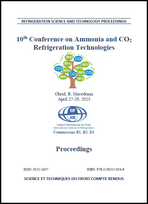
Document IIF
Fluides actif à haute température pour les pompes à chaleur : comment choisir le fluide optimal pour une application donnée.
High-temperature working fluids for heat pumps – A way to select the optimal fluid for a given application.
Numéro : 0007
Auteurs : PACHAI A. C., HAFNER A., ARPAGAUS C.
Résumé
Selecting the best working fluid or refrigerant for a heat pump system is not always so straightforward, especially not in the future. Many parameters will influence the final decision. In the first years of the history of refrigeration, the industry selected the refrigerants by what was most efficient and what was available. After the invention of chlorinated and fluorinated hydrocarbons in 1939, many companies started to use the so-called “safety refrigerants.” However, when it appeared to have a cost on ozone depletion using chlorinated hydrocarbons, and after the signature of the Montréal Protocol in 1987, the chlorinated versions quickly disappeared from the market in many parts of the world. From the start of the 21st century, fluorinated hydrocarbons became dominant and took over the markets previously served by the CFCs and HCFCs. However, it was already clear before the signature ink had dried in Montréal that these compounds’ next problem would become the global warming potential (GWP). Today, a new series of working fluids based on alkenes is close to market, with one or more double bonds. However, the drawback of these fluids has now been proven to have yet another dark side, the breakdown of products that come from the quick degradation in the atmosphere. From a manufacturer’s perspective, a major question is what way to go to future-proof products for more than a few years.
This paper investigates which refrigerants to use if the products are high-temperature heat pumps. The fluids (or gases) evaluated differ from those used in refrigeration and air-conditioning systems, although they have many of the same properties at higher temperature levels. Selection criteria like molecular mass, triple point, etc., are discussed. The most promising and first in line to reach the market will be R-600 (n-butane) and R600a (iso-butane) for temperatures up to about 130 °C and R-601 (n-pentane) and R-601a (iso-pentane) up to about 160 to 180 °C. Above these temperatures, reality also kicks in with limits, primarily oil, that have a problem when reaching close to 200 °C. An oil-free compressor on the water side can lift the temperature to 230 to 250 °C as either hot water, under pressure, or steam.
Considering the war in Europe, energy prices are going through the roof, decarbonization, and gas boilers are under pressure. Also, boilers are being targeted and put on the unwanted list in the US (DOE US). Some countries have moved to biomass and wood of different kinds, but that is also under increased criticism because of limited resources. The uptake of CO2 from new plants and trees is not enough and is slow, so this energy source is not viable.
Heat pumps are becoming the best available technology (BAT) for high temperatures over 65 °C and can go up to about 350 °C. Hydrogen is not competitive (Decarbonise Heating UK) due to loss and energy for production and is too valuable for technologies and activities where heat pumps fit in. Electrical heaters are also a better solution than hydrogen in many cases for lower-temperature heating, e.g., space heating.
Documents disponibles
Format PDF
Pages : 10
Disponible
Prix public
20 €
Prix membre*
Gratuit
* meilleur tarif applicable selon le type d'adhésion (voir le détail des avantages des adhésions individuelles et collectives)
Détails
- Titre original : High-temperature working fluids for heat pumps – A way to select the optimal fluid for a given application.
- Identifiant de la fiche : 30030966
- Langues : Anglais
- Sujet : Technologie
- Source : 10th IIR Conference on Ammonia and CO2 Refrigeration Technologies.
- Date d'édition : 27/04/2023
- DOI : http://dx.doi.org/10.18462/iir.nh3-co2.2023.0007
Liens
Voir d'autres communications du même compte rendu (38)
Voir le compte rendu de la conférence
Indexation
-
Theoretical investigation of high-temperature h...
- Auteurs : BLESS F., ARPAGAUS C., BERTSCH S.
- Date : 31/08/2021
- Langues : Anglais
- Source : 13th IEA Heat Pump Conference 2021: Heat Pumps – Mission for the Green World. Conference proceedings [full papers]
- Formats : PDF
Voir la fiche
-
Decarbonizing steam generation with high temper...
- Auteurs : HÖGES C., VENZIK V., VERING C., MULLER D.
- Date : 15/05/2023
- Langues : Anglais
- Source : 14th IEA Heat Pump Conference 2023, Chicago, Illinois.
- Formats : PDF
Voir la fiche
-
Experimental analysis of a R600 high-temperatur...
- Auteurs : VERDNIK M., RIEBERER R.
- Date : 07/12/2020
- Langues : Anglais
- Source : 14th IIR-Gustav Lorentzen Conference on Natural Refrigerants (GL2020). Proceedings. Kyoto, Japon, December 7-9th 2020.
- Formats : PDF
Voir la fiche
-
Development and analysis of a high-temperature ...
- Auteurs : HASSAN A. H., PAYÁ J., NAVARRO-PERIS E.
- Date : 13/06/2022
- Langues : Anglais
- Source : 15th IIR-Gustav Lorentzen Conference on Natural Refrigerants (GL2022). Proceedings. Trondheim, Norway, June 13-15th 2022.
- Formats : PDF
Voir la fiche
-
Experimental and model-based analysis of an R60...
- Auteurs : VERDNIK M., RIEBERER R.
- Date : 13/06/2022
- Langues : Anglais
- Source : 15th IIR-Gustav Lorentzen Conference on Natural Refrigerants (GL2022). Proceedings. Trondheim, Norway, June 13-15th 2022.
- Formats : PDF
Voir la fiche
